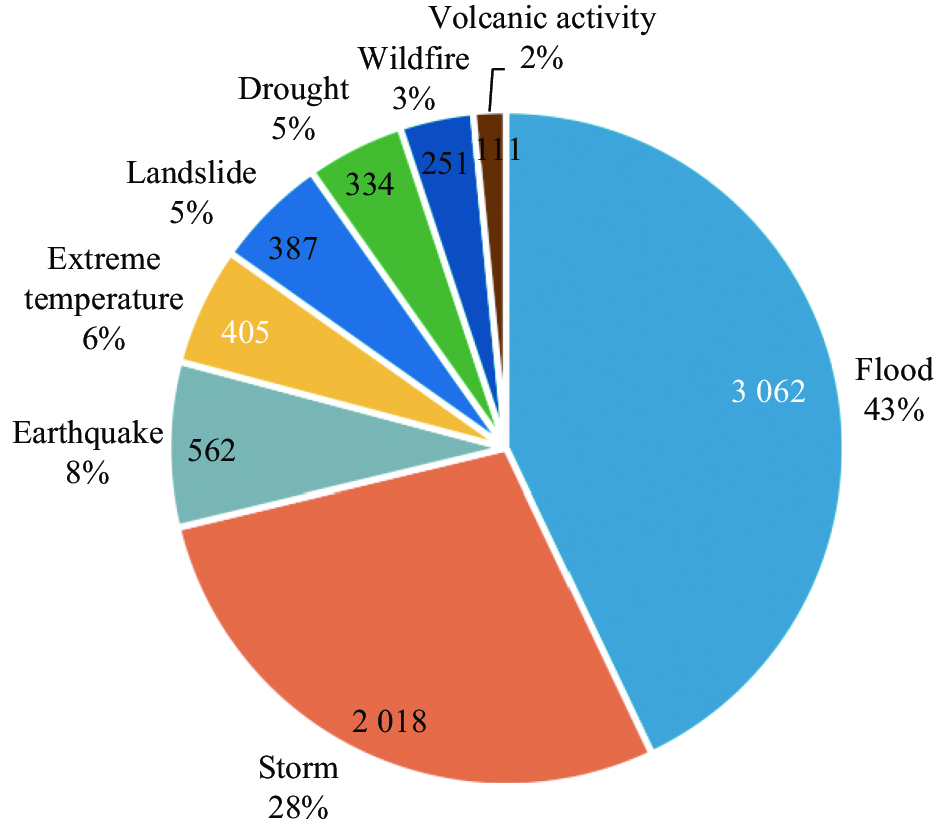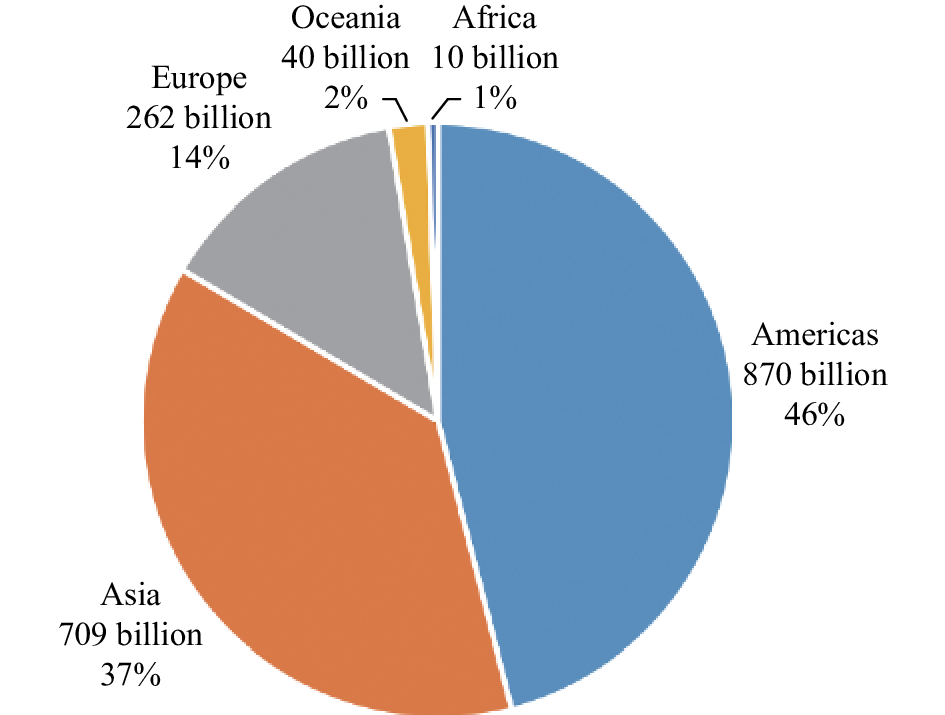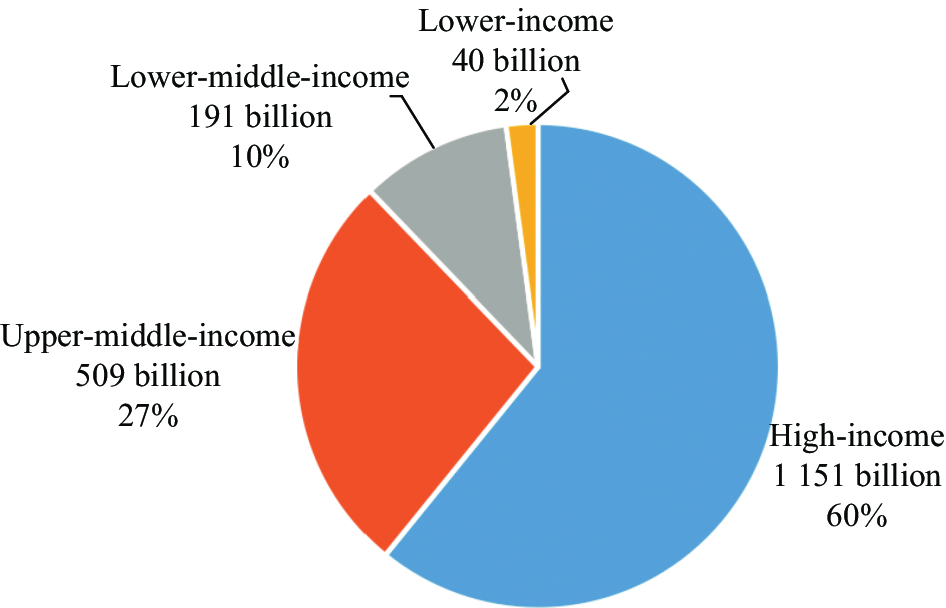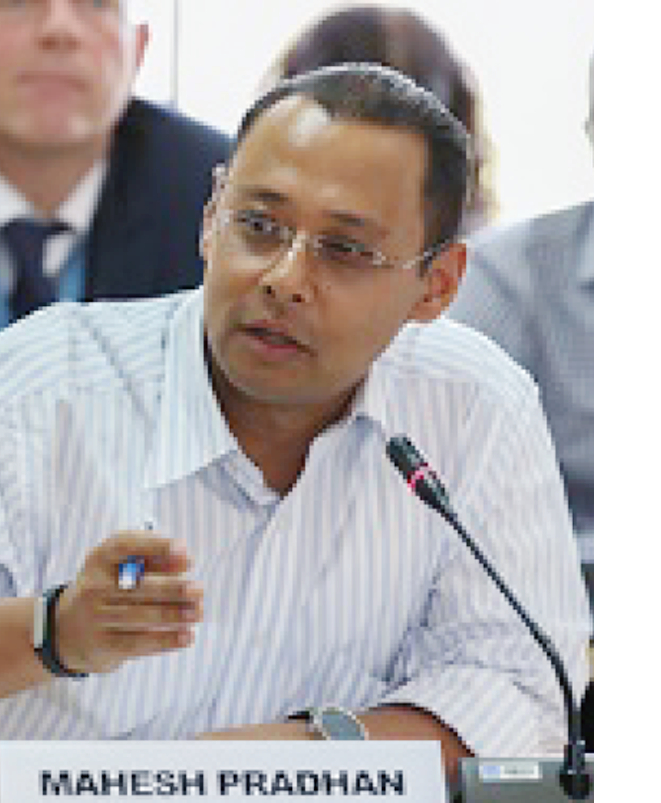2. Sichuan Academy of Environmental Sciences, Chengdu 610041, China
Natural disasters have considerably increased over the years resulting in an increase in corresponding damage costs. Waste generated after a disaster presents a major impediment to rescue operations and to the delivery of humanitarian aid. It also poses a risk to health, safety, the environment and to livelihoods recovery. Extreme events, whether “natural” or “manmade”, often make it difficult to properly manage normal waste streams. These challenge are often exacerbated by the generation of large amounts of additional waste—both hazardous and general, presenting additional challenges for civil society, local and national governments, private sector and humanitarian and emergency responders, as well as for communication and other support systems.
Disaster waste management (DWM) is only a recent focus of both disaster research and management. In earlier times, priority was on recovery and rebuilding efforts. Many existing policies and plans, whether they relate to waste management or to disaster risk management, do not address the need for sound management of disaster generated waste.
With increasing understanding of environmental and health impacts of disaster waste, there is an urgent need to mainstream disaster waste management. While disasters themselves are episodic, disaster waste management needs to be an ongoing priority, rather than just during and after a disaster.
1 DisastersAccording to the Emergency Events Database of the UN Office for Disaster Risk Reduction (UNISDR), natural disasters can be classified into several categories (Tab. 1). Hydrological, meteorological, climatological disasters are also collectively known as weather-related disasters. In this article, natural disaster implies geophysical and weather-related disasters.
| Tab. 1 Categories of natural disasters |
 |
While the trends in the number of geophysical disasters are relatively steady, weather related disasters have increased considerably over the recent years, resulting in an increase in corresponding damage costs. Between 2005 and 2014, there was an average of 335 weather related disasters per year. This was an increase of 14% on the previous 10 years (1995—2004), and nearly double the level recorded from 1985 to 1994 (Fig. 1)[1].
 |
| Fig. 1 Occurrence and cost of weather related disasters (1916—2016) |
According to the data provide from UNISDR, when looking at the frequency of natural disasters between 1995 and 2015, storms and floods account for over 70% of the world’s natural disasters, with earthquakes listed as third (Fig. 2). In order to be recorded as a natural disaster in UNISDR’s database, an event must meet at least one of the following criteria: ten or more people reported killed; 100 or more people reported affected; declaration of a state of emergency; and/or call for international assistance.
 |
| Fig. 2 Percentage of occurrences of natural disasters by disaster type (1995—2015) |
Disasters can be particularly notable for the high costs associated in response and recovery (Fig. 3). This figure is a minimum given widespread under-reporting of losses around the globe. With this caveat, storms cost more than any other type of disaster in terms of recorded lost assets (US$1 011 billion), followed by earthquakes (US$763 billion) and floods (US$662 billion). According to UNISDR’s 2015 Global Assessment Report on Disaster Risk Reduction[2], expected Annual Average Losses (AAL) from earthquakes, tsunamis, tropical cyclones and river flooding are estimated at US$314 billion in the built environment alone. AAL is the amount that countries should be setting aside each year to cover future disaster losses; it represents an accumulating contingent liability.
 |
| Fig. 3 Breakdown of recorded economic damage (US$) by disaster type (1995—2015) |
The costs of disasters vary considerably depending on a range of factors, such as the geographical location of occurrence. At the regional level, recorded losses in the Americas accounted for 46% of the total, followed by Asia at 37% (Fig. 4). This can be attributed to their large and heterogeneous landmasses and population concentrations.
 |
| Fig. 4 Absolute losses by continent (US$) (1994—2015) |
When a disaster occurs in a densely populated area in a developed country, financial damages can be huge, but when a comparable disaster occurs in a densely populated area in a developing country, the actual financial damage might be relatively smaller. Such a major contrast can be seen in Fig. 5, between 1995 and 2015, low- and lower-middle-income countries reported just 12% of economic losses, against 88% for high- and upper-middle-income nations.
 |
| Fig. 5 Income group analysis of economic damage (US$) |
2 Disaster waste
Disaster waste refers to solid and liquid waste generated from a disaster. Common disaster waste examples include: concrete, steel, wood, clay and tar elements from damaged buildings and infra-structures; household furnishings; parts from the power and telephone grids such as electrical poles, wire, electronic equipment, transformers; parts from water and sewage distribution systems; natural debris such as clay, mud, trees, branches, bushes, palm tree leaves; chemicals, dyes and other raw materials from industries and workshops; waste from relief operations; damaged boats, cars, buses, bicycles; unexploded ordnance (e.g., landmines); waste from disaster settlements and camps including food waste, packaging materials, excreta and other wastes from relief supplies; pesticides and fertilizers; household cleaners; paint, varnish and solvents; and healthcare waste[3].
A simple matrix to identify expected waste categories from different disasters has been developed by the United States Federal Emergency Management Agency. The typical waste streams for different disasters are shown in the Tab. 2[4].
| Tab. 2 Typical waste streams for different disasters (an example of US) |
 |
Disasters leave behind tremendous amounts of waste, in particular high amounts of debris and construction and demolition waste. Such waste is generated not only through the initial disasters, but also during the response and recovery phases[5]. Emergency and rebuilding operations generate substantial amounts of waste because of the lack of segregation, and uncontrolled storage and dumping. This waste might, for example, consist of health care products, packaging from basic provisions or demolition waste.
Generally, the volume of waste generated during disasters is illustrated in Fig. 6[6]. Municipal solid waste declines in the immediate aftermath of a disaster, and is overshadowed by demolition waste and healthcare waste. The waste for Internally Displaced Persons (IDPs) increased during the initial recovery period, which gradually decreases over time.
 |
| Fig. 6 Disaster waste generation phase |
The quantity of disaster waste varies based on the type of disaster and the built environment impacted.Tab. 3 shows reported waste quantities generated from some previous large scale disasters. The 2004 Tsunami in the Indian Ocean indicates that the waste generated in each community was equivalent to between 5 and 15 times their normal annual waste generation[7–8]. The 2015 earthquake in Nepal, which killed more than 9 000 people and destroyed 800 000 buildings, generated 3.94 million tons of debris in Kathmandu valley only, which was equivalent to 11 years of waste generation[9].
| Tab. 3 Reported waste quantities from previous disasters |
 |
Disaster waste quantities are reported either in terms of mass or volume. None of the disaster waste quantities reported explicitly stated how they were measured (for example, truck loads or landfill volumes), calculated or estimated (for example, waste volumes or mass per house or per affected area).
Meanwhile, most of the disaster waste quantity data comes from disasters in the US and Japan, which is largely due to the established disaster waste management processes. Hence, reliable disaster waste data is a challenge for most developing countries.
3 Disaster waste managementIn 2005, the Hyogo Framework (UNISDR) was developed to reduce disaster risk, particularly in vulnerable developing economies. Planning for disaster recovery, including management of disaster waste, is part of the disaster risk reduction strategy. However, financial, technical and expert resources in developing countries are generally a limiting, if not prohibitive, factor in achieving disaster risk reduction goals. Consequently, disaster waste management plans in developing countries seldom exist. In many cases “peace time” solid waste management programmes do not even exist—indicating that solid waste management is a low priority.
The UN Environment—OCHA Joint Environmental Unit (JEU) have published Disaster Waste Management Guidelines, specifically for developing countries[3]. Management and implementation strategies are designed for countries with little or no existing infrastructure and/or waste management expertise. Opportunities for livelihood promotion and maximising value from the resources are also emphasised.
Aside this guideline from JEU, there are several documents available to guide first responders specifically in dealing with disaster waste, which including: World Health Organisation “Solid Waste Management in Emergencies”[18]; Guidelines for Safe Disposal of Unwanted Pharmaceuticals in and after Emergencies (WHO, 1999); etc. All these documents cover solid waste disposal very generally and tend to focus on immediate management of waste generated in an emergency, such as municipal wastes in displaced populations, refugee camps, or where solid waste infrastructure is not functioning. They do not generally cover management of disaster-generated waste.
Disaster waste management covers the full cycle of assessments, collection/removal, safe demolition (in case of debris), transportation, land fill management, reuse/recycling, community engagement and in most cases support to the national and local authorities in the way of capacity development as well as the development of national strategy. Effective disaster waste management helps manage risks to life and health and presents opportunities for livelihoods recovery. When done right, timely and proper disaster waste management makes response more efficient, conserves natural resources and lays the foundation for long-term recovery.
After a review of current guidelines and reports on DWM as well as the waste management system in developing countries, some of the key issues include the following: 1) clear definition of DWM which is not only disaster debris clearance or solid waste management in humanitarian actions; 2) promote DWM from the aspect of environmental and public health risk reduction as well as quick and cost effective management of disaster waste including the resource efficiency context in collaboration and coordination with stakeholders; 3) preparedness for effective DWM is key.
4 UN environment’s approach to disaster waste managementThe importance of preventive action and preparedness to manage environmental impacts of natural and man-made disasters is recognised in UN Environment’s Governing Council Decision UNEP/GC.26/15 on Strengthening International Cooperation on the Environmental Aspects of Emergency Response and Preparedness (February 2011), which calls for the provision of technological support, capacity development and resources for prevention, preparedness and response.
In the Sendai Framework for Disaster Risk Reduction (DRR) 2015—2030, adopted at the Third UN World Conference on DRR in March 2015, the importance of enhancing disaster preparedness for effective response, and to “Build Back Better” in recovery, rehabilitation and reconstruction was highlighted as one of its four priorities for action. The main features of the Sendai Framework are: 1) shifting focus from managing disasters to managing risks; 2) a wider scope, encompassing the risk of small- to large-scale, frequent and infrequent, sudden and slow-onset disasters, caused by natural or man-made hazards, as well as related environmental, technological and biological hazards and risks; and 3) a more people-centred, all-hazards and multi-sectorial approach to DRR[19].
On the other hand, disaster waste management is cross-cutting issue, as shown in Fig. 7.
 |
| Fig. 7 Cross sector approach for disaster waste management |
In UN Environment’s Global Waste Management Outlook[20], which provides a general overview of the state of Waste Management globally, disaster waste is highlighted under Chapter 3 Global Status of Waste Management. It emphasizes the importance of having a Disaster Waste Management Contingency Plan in place before an emergency occurs and how this helps in identifying options for waste collection, recycling and disposal and saves time and resources, which are critical factors following a disaster.
UN Environment’s Global Waste Management is being complemented by regional and thematic Waste Management Outlooks, which allow for deeper analyses and recommendations better tailored to each region. A specific sections of disaster waste management was developed in the Waste Management Outlook for Mountain Regions[21] and Small Island Developing States (SIDS)[22]. Both of the regions are particularly vulnerable to natural disasters because of their high degree of exposure and their low coping capacity (often due to poverty). Recommendations include obtaining good quality data on shocks, stresses, hazards and vulnerabilities; implementing more stringent construction standards and plans for safer buildings and infrastructure; legalizing and regularizing informal settlements; preserving productive and protective ecosystems (for example, through an ecosystem-based adaptation approach); and building local capacity to respond rapidly to disasters.
UN Environment convened a group of environment and disaster waste experts and professionals in Geneva in November 2016 to examine the state of play and opportunities for better coordination of disaster waste management. A joint statement on disaster waste management stemming from this meeting called for enhanced action to support national and local partners to be better prepared for managing waste in the aftermath of disasters and/or conflict. It was noted that coordination structures for management of disaster waste vary according to the context but need to be incorporated within existing governance structures. There is a need to find simple, fast and pragmatic solutions for disaster waste management, which respond to the reality of disaster environment. The participants recommended further joint activities be carried out, focusing on operationalising disaster waste management in all phases of humanitarian action (namely—preparedness, response and recovery).
In UNEP’s Medium Term Strategy (MTS) for 2018—2021, Sub-programme 2 Resilience to Disasters and Conflicts includes a project entitled “Environmental Impact of Humanitarian Operations, Including Disaster Waste Management”, on a collaborative basis between IETC and the Joint UNEP/OCHA Environment Unit (JEU). This project aims to enhance coordination between humanitarian and environment actors and better awareness and uptake of respective tool(s) for environmental assessment and management in humanitarian action, including focus on disaster waste management. Project actives include two major components:
1) Gap analysis of current waste management strategies, leading to stakeholder consultations in identification of strategic options for effective disaster waste management. These strategic options will be translated through detailed action plans and demonstrations for pilot cities/towns/regions.
2) Development of pilot programs for hazardous waste management in target countries focusing on: ① data collection and the assessment and quantification of impacts on the environment, health and livelihoods; ② capacity building and training for local actors; ③ development of transformative agendas empowering local actors.
UN Environment’s International Environmental Technology Centre (IETC), as UN Environment’s designated entity for addressing waste issues including disaster waste, aims to practically demonstrate how environmental considerations can and should be an integral component in humanitarian preparedness and response in priority countries. To achieve this goal, IETC addresses issues both at a systematic/institutional level and on the ground, through in-depth situations analyses and needs assessments, technical support and capacity building of advocacy and the provision of tailored guidance and tools, as well as cost-effective approaches that will have a lasting impact for the most vulnerable and at-risk communities.
In February 2017, with support from the Osaka City Government, UN Environment IETC conducted the Symposium on Mainstreaming Disaster Waste Management, followed by a scoping workshop and field visit. Over 80 participants and representatives from 12 different countries shared their experiences and ideas in order to improve international cooperation on DWM. As the outcomes of the symposium and scoping workshop, 2 pilot projects were identified: 1) the Quezon City Government in the Philippines will introduce of disaster waste management in the local “Barangay” settings, with focus on capacity building; 2) Nepal will attempt to mainstream DWM into the existing waste management strategy and other development strategies, with focus on outreach and communication.
In September 2017, the Environment and Emergencies Forum (EEF), hosted by UN Environment in Nairobi, explored the nexus of environmental risk and humanitarian crisis against global trends and provided a platform for taking action to strengthen environmental resilience through an increased focus on the readiness of member states, regional and national organizations, civil society and academia, to address the environmental dimensions of emergencies. A side event on disaster waste management was organised during the 2017 EFF, which discussed: 1) mainstreaming waste management/DWM within disaster preparedness; 2) DWM in recovery and reconstruction—building back better and addressing livelihood; and 3) disaster contingency planning in local and national waste action plans. The breakout groups were designed to identify opportunities for enhanced networks and cooperation between participants. As the session’s outcomes, Swedish Civil Contingencies Agency (MSB) will update the existing DWM Guidelines; the Ministry of the Environment, Japan will develop a region-specific DWM Guideline for Asia and the Pacific for increased hands-on usability. The session emphasized the need for a training or mentoring programme to support such efforts, including the further dissemination of the DWM guidelines and experiences.
In addition, UN Environment is working with Nepal and the Philippines on pilot projects on disaster waste management focusing on policy development, demonstration activities, and communication/outreach. These pilot projects include: 1) integrating disaster contingency planning in national and city level waste management strategies; 2) mainstreaming waste management issues within broader disaster preparedness and response plans and actions; 3) awareness rising and capacity-development, such as “training of trainers” events on key DWM tools and guidelines.
5 ConclusionDisasters often generate large quantities of waste that threaten public health, hinder rescue and reconstruction efforts and may significantly damage overall recovery efforts, and negatively impact the environment. Effective disaster waste management helps manage risks to life and health and presents opportunities for resilience and livelihoods recovery. When done right, timely and proper DWM makes response more efficient, conserves natural resources and lays the foundation for long-term resilience and recovery.
Usually, debris clearance has the highest priority following a disaster because of the need to provide access, rescue survivors, retrieve dead bodies and address urgent public health and environmental issues. Management of the disaster waste differs according to response phases, but also depends on the types of waste and debris generated and the management options available.
As the Sendai Framework for DRR 2015—2030, which replaced the Hyogo Framework for Action 2005—2015, with a broader perspective on Disaster Risk Reduction, the scope of disaster waste management now not only covers debris clearance and waste management immediately following a disaster, but also includes prevention and preparedness aspects in terms of enhancing resilience of local communities to extreme climate events, natural disasters, and other hazards. In conclusion, preparedness is the key for effective disaster waste management.
| [1] |
United Nations International Strategy for Disaster Reduction.The hunman cost of weather related disasters 1995—2015[R].Geneva:UNISDR,2015.
|
| [2] |
United Nations International Strategy for Disaster Reduction.Making development sustainable:The future of disaster risk management[R].Geneva:UNISDR,2015.
|
| [3] |
Joint United Nation Environment Programme/Office of the Coordination of Humanitarian Affairs Environment Unit.Disaster waste management guidelines[R].Geneva:JEU,2011.
|
| [4] |
U. S. Federal Emergency Management Agency.Debris management guidelines[R].Washington D. C. :FEMA,2007.
|
| [5] |
United Nations Environment Programme,International Solid Waste Association.Global waste management outlook[R].Nairobi:UNEP and Vienna:ISWA,2015.
|
| [6] |
United Nations Environment Programme,Swedish Civil Contingencies Agency.Disaster waste management framework[R].Nairobi:UNEP and Sweden:MSB,2008.
|
| [7] |
Reinhart D R,McCreanor P T.Disaster debris management—Planning tools[R].Atlanta:Environmental Protection Agency Region IV,1999.
|
| [8] |
Basnayake BFA,Chiemchaisri C,Visvanathan C.Wastelands:Clearing up after the tsunami in Sri Lanka and Thailand[N/OL].Waste Management World,2006-02-04[2018-03-02].https://waste-management-world.com/a/wastelands.
|
| [9] |
Gyawali S.Kathmandu’s uncoordinated attempt to manage 2015[N/OL].Earth Island Journal,2015-08-06[2018-03-02].http://www.earthisland.org/journal/index.php/elist/eListRead/kathmandus_uncoordinated_attempt_to_manage_earthquake_debris/.
|
| [10] |
Ministry of Environment Japan.Framwork of disaster waste management guideline in Asia and the Pacific[R].Tokyo:MoEJ,2015.
|
| [11] |
Brown C,Milke M,Seville E. Disaster waste management:A review article[J]. Waste Management, 2011, 31(6): 1085-1098. DOI:10.1016/j.wasman.2011.01.027 |
| [12] |
Ramzy A.The Sichuan earthquake,six months later[N/OL].Time,2008-11-12[2018-03-02].http://content.time.com/time/photogallery/0,29307,1861081,00.html.
|
| [13] |
Lurther L.Disaster debris removal after Hurricane Katrina:Status and associated issues[R].Washington D. C. :Congressional Research Service,2008.
|
| [14] |
U. S. Solid Waste Authority.2003—2004 annual report:Mountains of debries[R].West Plam Beach:SWA,2004.
|
| [15] |
Bjerregaard M.MSB/UNDP debris management guidelines[R].Stockholm:MSB,2010.
|
| [16] |
Baycan F,Petersen M.Disaster waste management_C&D waste[C]//Proceedings of the Annual Conference of the International Solid Waste Association,Turkey,2002.Vienna:ISWA,2002:122–125.
|
| [17] |
Hirayama N,Kawata Y,et al.Estimation procedure for potential quantity of tsunami debris on tsunami earthquake disasters[C]//Proceedings of the Twelfth International Waste Management and landfill Symposium,Italy,2009.Italy:Sardinia,2009:74–78
|
| [18] |
World Health Organization.Solid waste management in emergencies[R].Geneva:WHO,2005.
|
| [19] |
United Nations International Strategy for Disaster Reduction.Sendai Framework for disaster risk reduction 2015—2030[R].Geneva:UNISDR,2015.
|
| [20] |
United Nations Environment Programme.Global waste management outlook[R].Nairobi:UNEP,2015.
|
| [21] |
Alfthan B.Waste management outlook for mountain regions—Sources and solutions[R].Nairobi:UNEP,Arendal:GRID-Arendal and Vienna:ISWA,2016.
|
| [22] |
United Nations Environment Programme.SIDS waste management outlook[R].Nairobi:UNEP,2018.
|
 2018, Vol. 50
2018, Vol. 50



